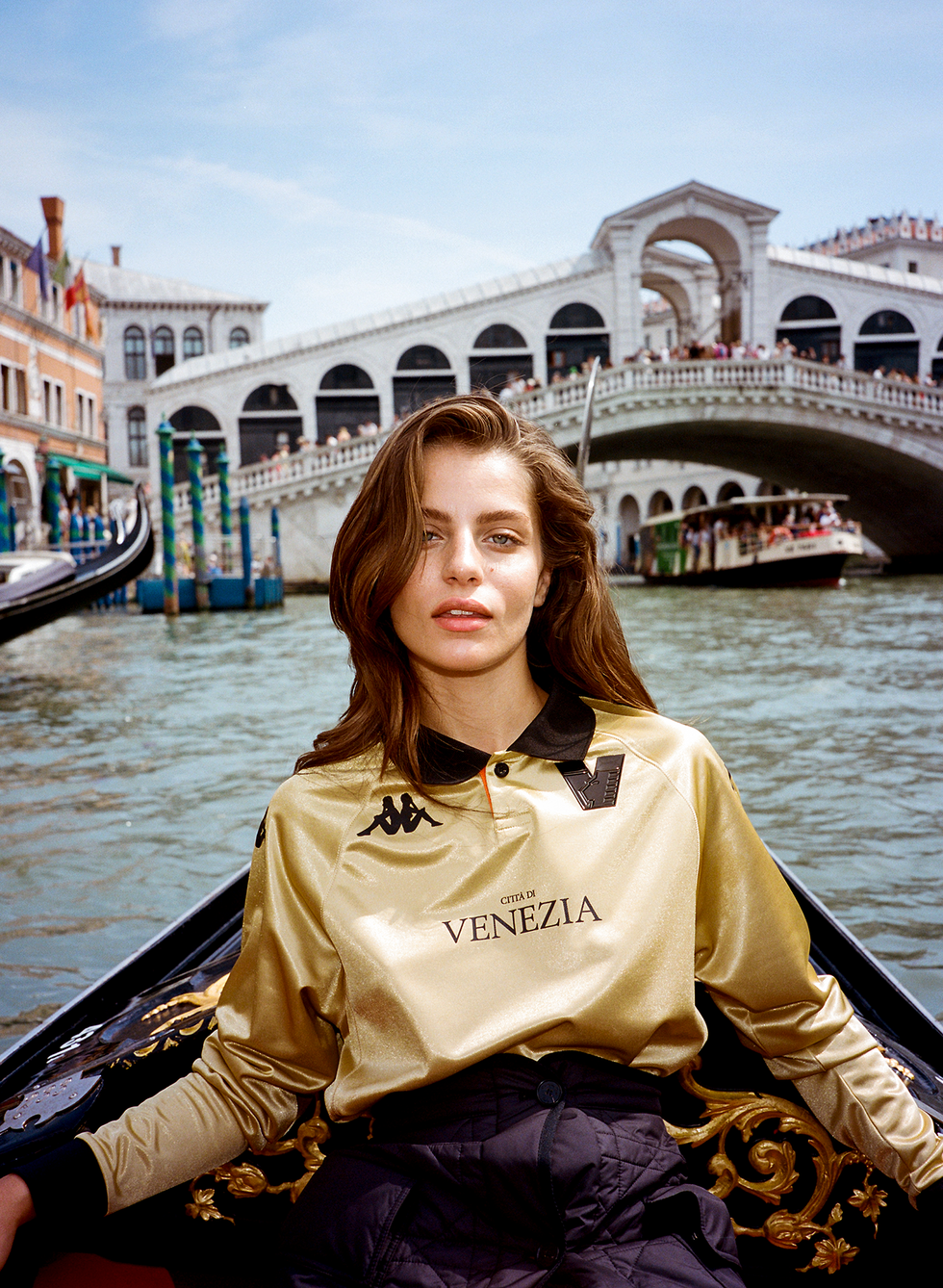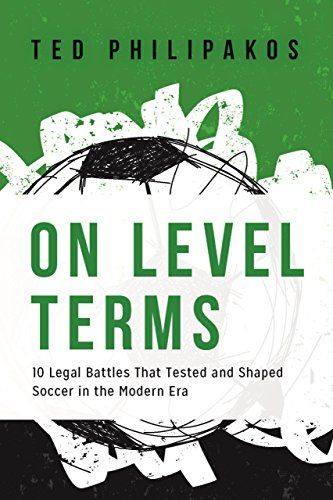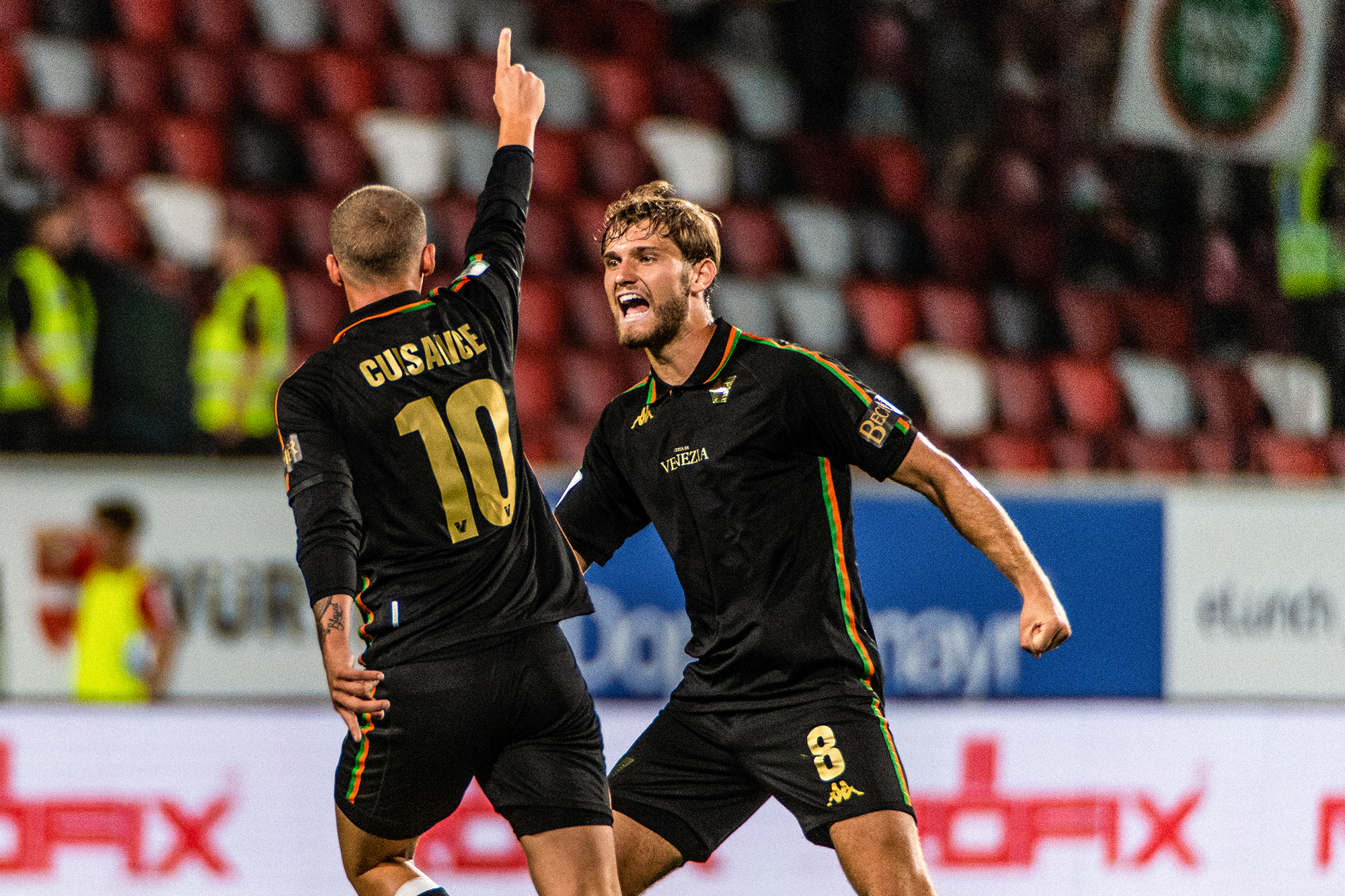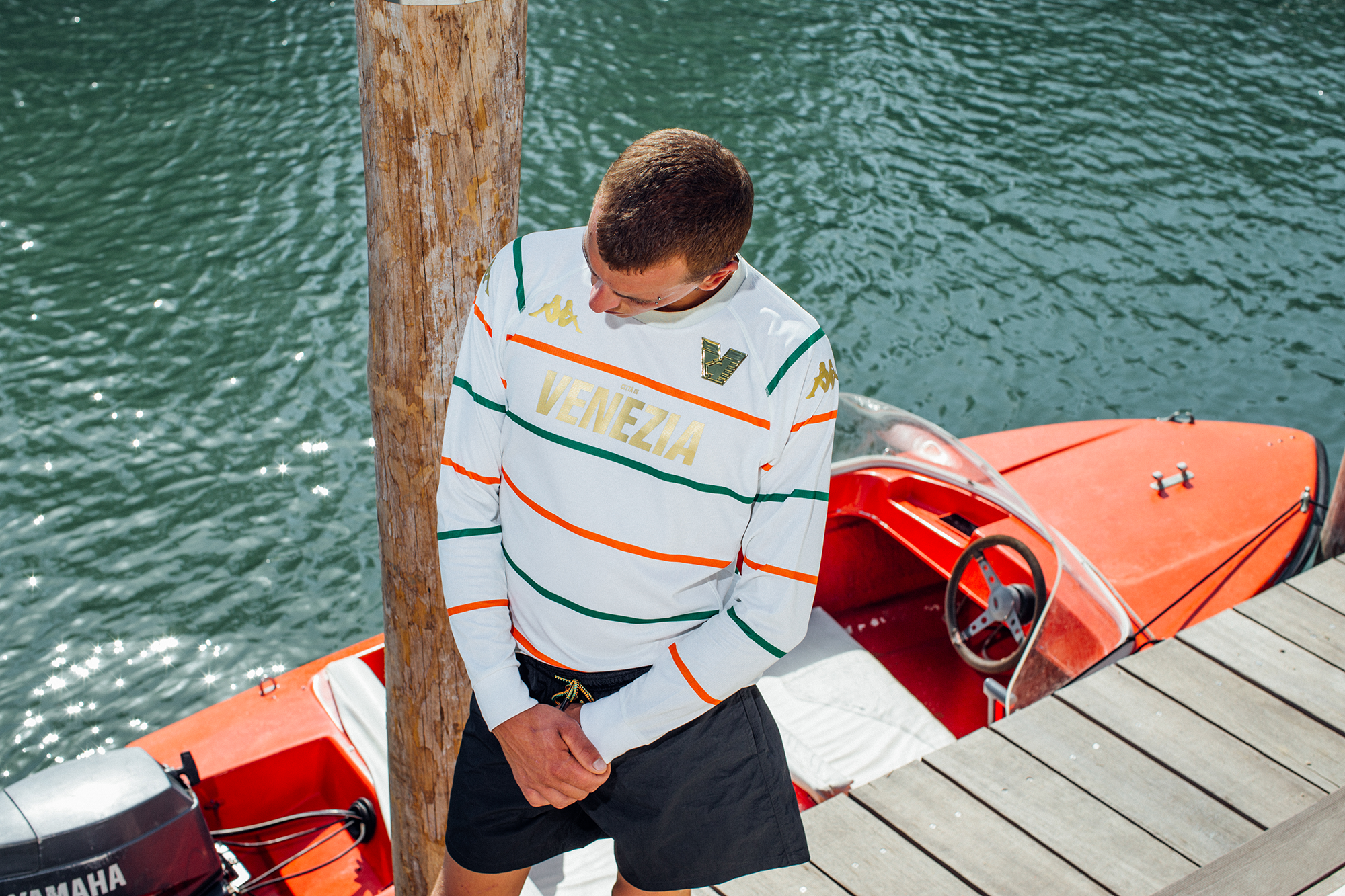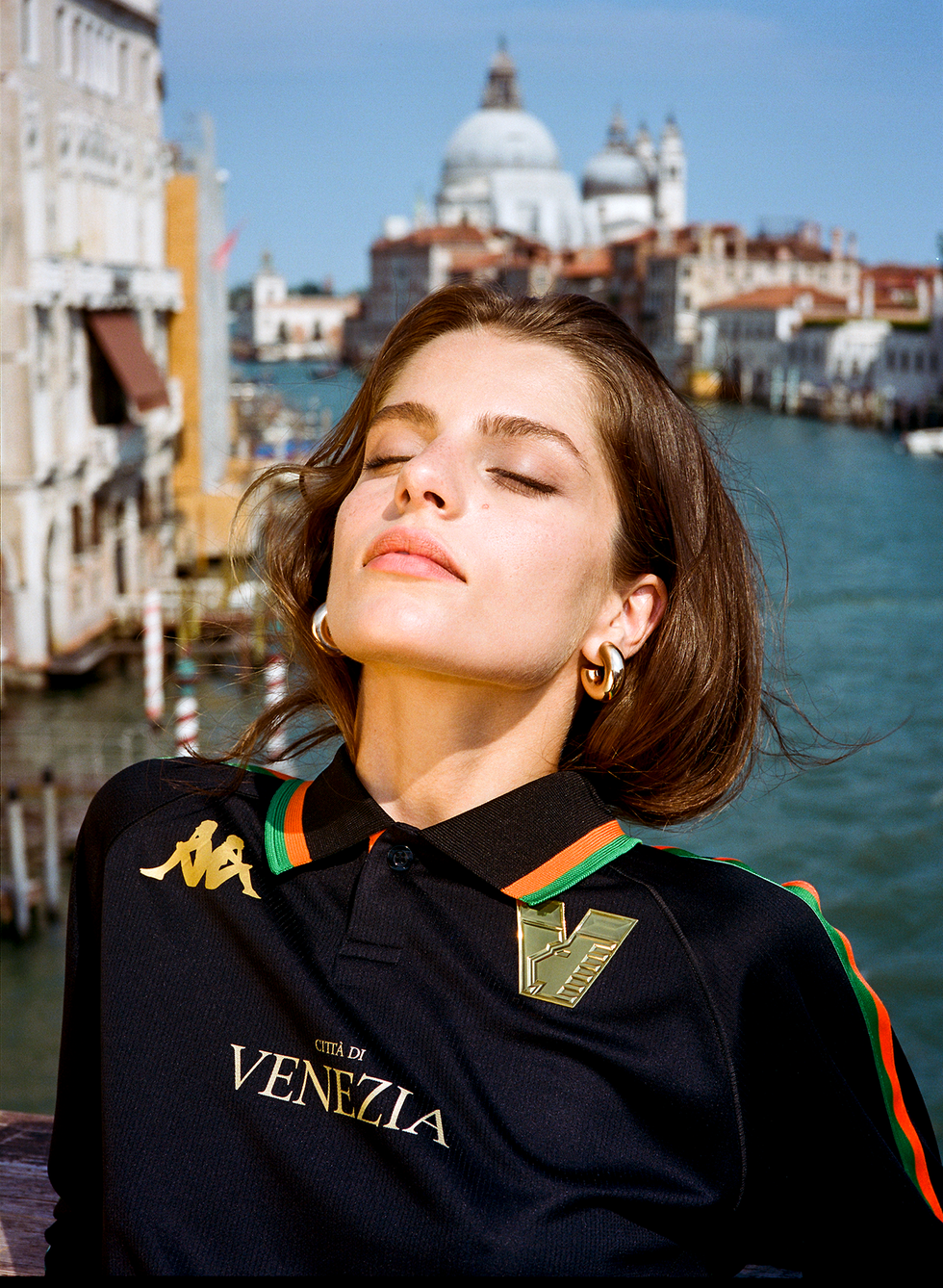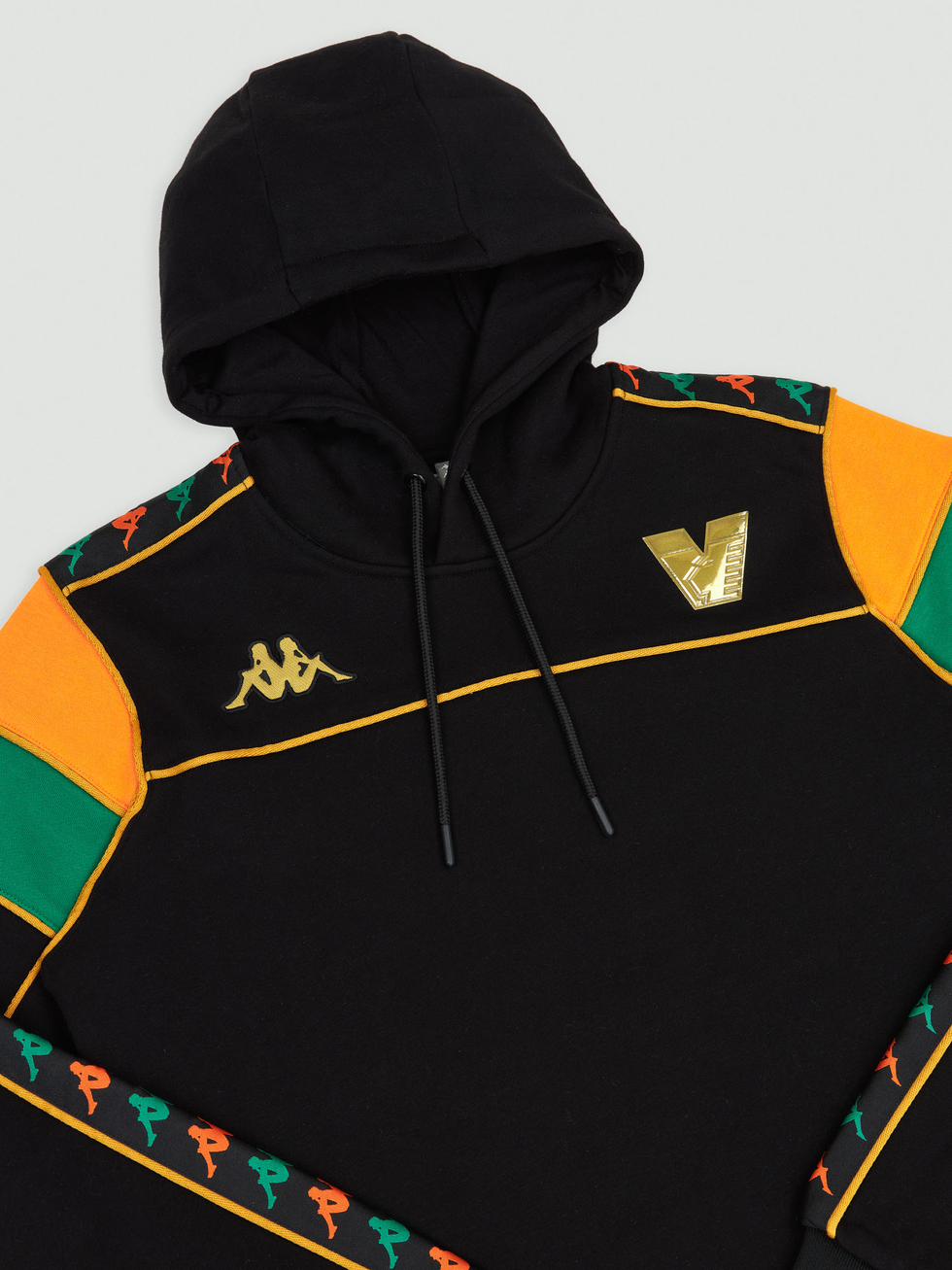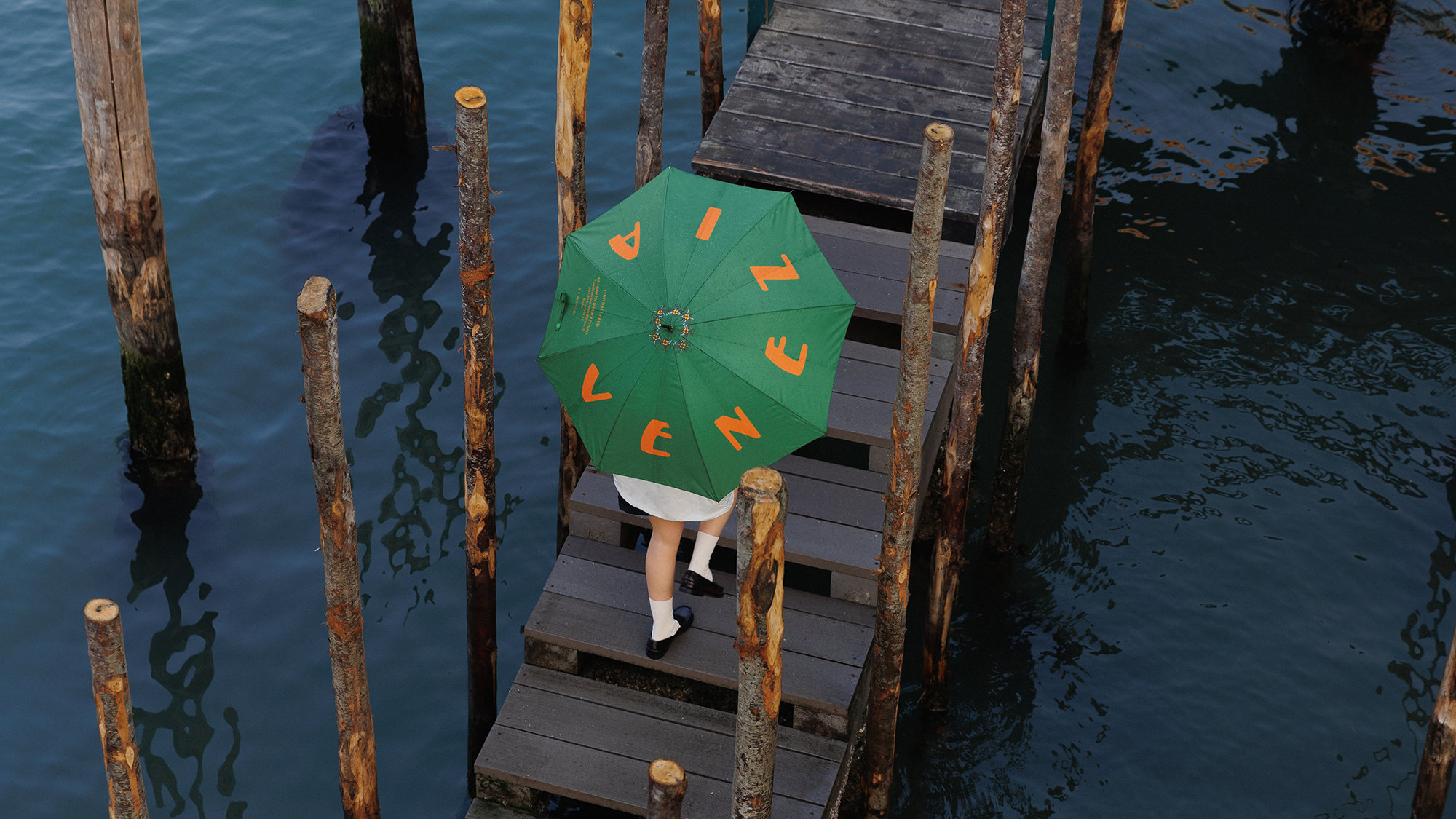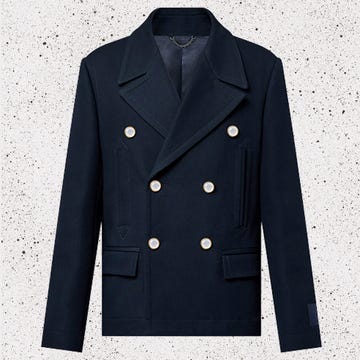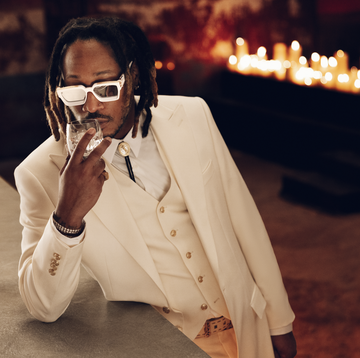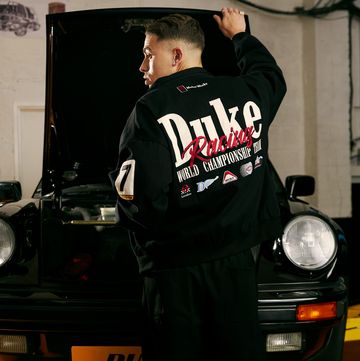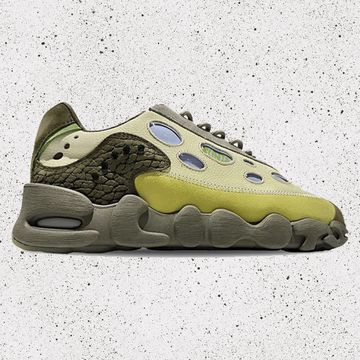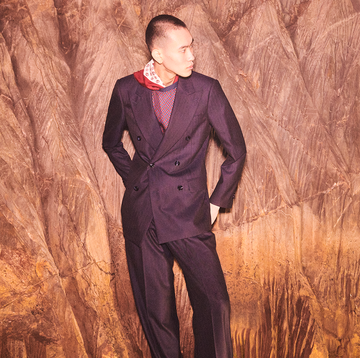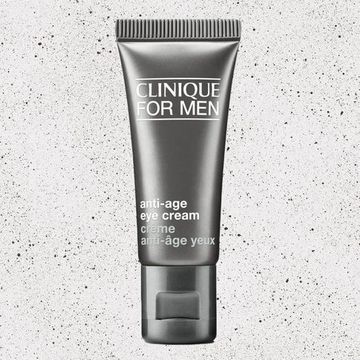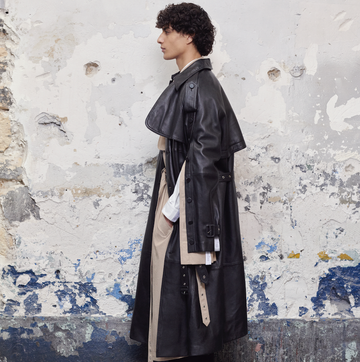On a Sunday morning in late August, I went into a store on Calle Larga Mazzini in Venice, a street that runs down to the Grand Canal, close to the Rialto Bridge. Outside, as the heat started to tighten its grip, the sounds of the city ricocheted against the ancient walls: chattering tourists, street sellers; the scrape of a thousand wheely cases dragged over medieval paving. But inside the store all was serene, ascetic. The floors were pale stone, softened by Afghan rugs; the changing rooms had houseplants and oxblood Chesterfield armchairs. In front of a floor-to-ceiling photograph of a beautiful girl having breakfast on the terrace of a Venetian hotel, two sales assistants stood at the low till, smiling patiently as I looked at the clothes, which were suspended from precisely spaced hangers on metal rails running along both walls. I pulled out a black-collared T-shirt with bright stripes running down the full-length sleeves; then another with a shoulder design of two silhouetted figures sitting back-to-back on a shirt of shimmering gold. Across the room one of the assistants asked me, still smiling politely, “Do you have tickets to the match?”
It might have the trappings of an upmarket boutique — the kind of intimate, carefully curated spaces more readily found in the world’s fashion capitals — but no. This was the flagship store of Venezia Football Club, an average football team languishing, at the time of writing, towards the bottom of Italy’s Serie B. Lowly league position be damned, however: over the past 18 months or so, in spite of its disappointments on the pitch, Venezia has undergone a transformation, earning a reputation, through a mixture of clever design and canny marketing strategy, as “the most fashionable football club in the world”.
The shirts hanging on the rails in the club’s Rialto store have been the key to their success. The Venezia FC replica kits have become objects of somewhat frenzied desire, as coveted by hype kids and fashionistas as they are by football fans; in fact, more so. It’s an unlikely feat for a team that boasts no famous players (its top goalscorer at the time of writing is French attacking midfielder Michaël Cuisance), no famous manager (in June this year, the club lured Croatia’s Ivan Javorčić from Serie B rivals Südtirol) and not even an illustrious history on which to draw. Yet despite — or perhaps, given the contrariness of the fashion industry, because — of its ordinariness, Venezia FC has nevertheless positioned itself on the razor’s edge of the zeitgeist. Clearly someone, somewhere, knows what they’re doing. But how did they achieve it? And, crucially, to what end?
Outside the store I met a Scottish man on holiday with his family, who offered a clue. He had just bought a shirt and had tried, without success, to convince his wife and children to get tickets to the match. He explained that he worked for a design agency in London, and Venezia’s rebrand had caught his eye. “It’s a fascinating story,” he told me. “But it’s not entirely about football.” No indeed.
“When I say we had to start from zero, I mean that very literally,” says Ted Philipakos, Venezia FC’s chief brand officer, and one of the architects of the club’s non-footballing renown. “No Instagram account, no Twitter account. Popularity in Venice was…” he pauses carefully, “to say ‘waning’ would be kind.”
It is the night before Venezia’s first game of the 22/23 season, and Philipakos — 41, broad shoulders, neat beard, in a fine-knit polo shirt — has booked us a table at Harry’s Bar, once the fêted literary hang-out of Guggenheim, Hemingway and Welles, and now the kind of place you might take tourists when you want to give them the elegance of Venice in its most distilled form.
Philipakos is something of an academic of the modern game, and he doesn’t exactly fit the blokeish mould of the traditional football exec. He’s from New York, for a start. Before joining the club, Philipakos was a players’ agent, a lecturer at New York University’s Tisch Institute for Global Sport and a writer, covering issues in American soccer and the worldwide game.
In 2015, he published a book called On Level Terms: 10 Legal Battles That Tested and Shaped Soccer in the Modern Era. He joined Venezia in 2015, when the club had come under new American ownership, and was recovering from what, in its 115-year history, could confidently be described as its nadir.
Venezia Foot Ball Club, as it was originally known, was founded in 1907. Matches are played at the Stadio Pier Luigi Penzo, an 11,000-capacity concrete stadium that teeters on the western edge of Sant’Elena, the island at the far eastern end of the city. The club’s self-described “golden era” was in the early 1940s, when they won the Coppa Italia (the national cup — Venezia’s only major trophy win) and finished third in Serie A, the top flight of Italian football. Since then, Venezia had skittered up and down through the leagues and endured considerable financial upheavals, that resulted, in 2013, in the club’s third bankruptcy in 10 years.
Around the same time, Philipakos says he had identified a change in the global football landscape. “There was a technological evolution, a generational change and a psychographic shift, where this new generation had an entirely different relationship with football,” he recalls. “And, at the same time, beyond the relationship with what’s actually happening on the pitch, you started to see this blurring of the lines, this blending of football culture with broader culture. You saw an exchange between football and fashion, between football and other facets of modern culture. It just felt like a moment where a small club could engage more people than ever before, especially with stories that went beyond the pitch.”
Perhaps a football club, acting like a “brand”, could capitalise on those changes. And Venezia would be the perfect place. Aside from the club being over a century old, the city itself offered unparalleled culture, history, romance and touristic appeal. Though his first stint at Venezia FC lasted only a year — he is reticent about this but I assume it was a disillusionment with certain business strategies — he rejoined in 2020, under new club president and former CEO of the New York Stock Exchange Duncan Niederauer, who, he says, gave him the support to forge ahead with some bold changes.
One of the first moves was to break away from then-sponsor Nike and take up with the Italian sportswear company Kappa. “They have a wonderful heritage going back to the 1990s [when the brand was synonymous with Italian football, although it was founded in the 1970s], which is an important era for our club,” says Philipakos. “An era for aesthetics that we like to tap into.”
Crucially, Kappa offered the club creative control of the design. The result was a four-shirt collection — yes, four — ready in time for the 2021–’22 season. The look leant heavily on the Venetian locale. The black home kit featured a trompe l’œil Venetian wall texture, created from photographs of aged façades around the lagoon, and stars, which replicated those of the Basilica San Marco, arranged in a large “V” on the chest. The away kit had the club’s traditional “arancioneroverde” (orange, black and green) sprayed across the shirt in an ombré haze and a graphic triangle pattern designed to emulate Venetian mosaics. The third kit was blue, inspired by the lagoon, and the fourth kit was red, in honour of the "stendardo di San Marco”, the flag of Venice.
Three of the four kits featured on football culture website Soccer Bible’s list of the 20 best of the season; Venezia’s home shirt was ranked number one. The website described the collection as “nothing short of jaw-dropping. Not one, not two, but three unbelievable kits that well and truly put Venezia on the map”. Perhaps most groundbreakingly, the campaign imagery featured Greek model Theopisti Pourliotopoulou, a girl — a girl! — sitting on a sofa wearing the home shirt over a ruched-sleeve shirt. She has since become the face of the brand.
Meanwhile, the success of the shirts was being mirrored — somewhat fortuitously — by success on the pitch. At the end of the 2020/21 season, Venezia won promotion to Serie A. Soon, the new kit was lining up against those of Milan, Roma, Juventus, Inter and the rest, giving it much broader exposure than the club had expected. But looking the part didn’t prove to be enough. Venezia performed admirably in the first half of the
campaign, but eventually crumbled and were relegated to Serie B at the end of last season. A problem for a brand on the up, you might think.
“From the beginning, the stylisation of the brand, the importance we’ve given to the brand, it transcended what league we happened to be in,” says Philipakos, with surprising equanimity. “That was instructive for a moment like this, because now we’ve been relegated from Serie A to Serie B, and in my mind, it was like, ‘OK, just because we’ve fallen to the second division, that doesn’t mean we become second rate.’ We’ve been taking this seriously since the third division, so why would we do anything differently?”
In fact, despite the relegation of Venezia FC: The Team, Venezia FC: The Fashion Brand gathered pace. Philipakos had already broken with convention in his hiring policy, recruiting creatives who hadn’t necessarily come from the football industry — one new team member had worked at fashion brand Off-White, another at Venice’s prestigious art Biennale, and he brought Sonya Kondratenko, a social-media content creator and brand consultant, over from the US to be Venezia’s media director. Philipakos and his team pushed further into fashion-brand territory, first with a limited-edition collection of rainproof accessories, then a swimwear collection made in partnership with local brand, Lido. The former featured a branded umbrella, rain poncho, fisherman’s hat and scarf; the latter included shorts, bikinis and one-piece bathing suits. As with the release of the kit, the campaign imagery was highly stylised — the kind of thing you’d find in the fashion pages of a magazine rather than on a football club’s Instagram.
Of course, as any marketeer knows, successful brands don’t just offer something to buy, but something to buy into; selling stuff is good, but selling a lifestyle is better. Soon, Venezia FC’s website was publishing poetic essays on the city and interviews with such cultural luminaries as Cecilia Alemani, the artistic director of the Biennale. Even the post-match write-ups took on an impassioned editorial tone rarely seen in the game. Then came a Martin Parr-esque photography book documenting the 2021–’22 season, shot from the terraces by Venetian street-photographer Eric Scaggiante. On social media, the club leaned into an insouciant tone, one not typical in modern football, an industry famously dulled by its need to be both locally partisan and globally inclusive. In June, the club notified its followers of a new social-media account with this tweet: “Sadly, we’re on TikTok now. If you’re like 12, follow us there.” In July, commenting on a New York Times article about Elon Musk’s alleged termination of his purchase of Twitter, Venezia FC tweeted, “The sheer predictability does not diminish its splendour.” Huh? You wouldn’t get that at Wigan Athletic.
The major change, though, was an overhaul of the club’s visual identity by Bureau Borsche. The ultra-hip German design agency lists Balenciaga, Rimowa and Supreme as former clients, so it would have no trouble in “yassifying” Venezia FC, to use a term not often employed in football circles.
Bureau Borsche created a slick, image-driven website, a new, slightly brutalist club crest and three kit designs for the 2022–’23 season. The new home shirt — black with a gold crest and orange and green detailing, and long-sleeved — was unveiled in early July, modelled again by Pourliotopoulou, this time eating a croissant on the deck of a nice hotel on the Grand Canal or lounging in a gondola, and shot by fashion photographer Chris Kontos. The away shirt, white with horizontal green and orange stripes, dropped a few days later (a friend who had never heard of Venezia FC saw it on Instagram and bought it at once), then came the third shirt, an eye-catching gold number, also worn by Pourliotopoulou, this time reading the morning papers.
If the previous collection was a statement of arrival, this was a hint of what was to come. “Ultimately, I wanted to take the brand into a place that was more elegant, more refined," says Philipakos. Influential streetwear website Hypebeast stated that Venezia was “making its stamp on luxury fashion” and design news outlets It’s Nice That and Design Week ran profiles on the club’s new visual direction. Increasingly, the club was appealing to people not just outside of Venice, but way beyond Italy, too. Philipakos tells me that 96 per cent of merchandise sales are outside Italy, the biggest markets being the US, UK, western Europe, Japan and Korea.
To some, it was notable that the fortunes of the football club and those of the brand were starting to diverge. “I was quite cynical. Like, ‘If you’re going to get relegated from Serie A, maybe focus on that and don’t focus on releasing four kits a season [and] being mean to ESPN on Twitter’,” says Dan Sandison, co-founder and editor of football-culture magazine, Mundial. “That made me feel a bit silly and that I’d missed the point. Because now they’re in Serie B and whether they’re snarky on Twitter or not, they’re achieving something with the kits. What they achieve on the pitch is almost entirely separate.”
In business terms at least, Philipakos’s strategy seems to have been vindicated. Despite the relegation, Venezia sold four times as many shirts this season as they did in the last, he tells me.
It wasn’t until the late 1950s that the first replica football kits went on sale, and they were marketed to children. Commercially speaking, football clubs, write Simon Kuper and Stefan Szymanski in their bestselling 2009 book Soccernomics, were surprisingly slow on the uptake. “Only in the late 1980s did English football clubs discover that people were willing to buy replicas of their team shirts. That made it plain to even them that their gear must have some value.”
Kits got weird in the 1990s — a period of maximalist, poppy design kicked off by the World Cup in Italy, which saw Germany’s famous Adidas shirt with the jagged black, red and yellow lines, England’s mottled-blue Umbro shirt and Russia’s incredibly creepy blood-smeared-on-a-wall number. But even the inauguration of the Premier League and the advent of marketable superstar players like David Beckham and Cristiano Ronaldo didn’t really endear the kits to the more style-conscious consumer. You could be a fashionable football fan, but not in a replica shirt. Those were increasingly popular, but not among the style or even the sportswear cognoscenti.
This seems to have changed. “In 2002, if you wore a vintage Ajax shirt in a pub in London, you’d have been surrounded by fellas [aggressively] asking where you’re from,” says Sandison. “Whereas now that’s not the case. Football as a lifestyle thing has appeared in the last 10 years. Outside of football games there’s a dilution of the toxicity and partisan element. I could get away with an old Newcastle shirt and no one would bat an eyelid, or I could wear an Italy shirt to five-a-side and not get the graphic racial slurs you might have gotten 10, 15 years ago.”
It’s not just Venezia FC. The bigger clubs are now feeding the burgeoning kit culture, too, reissuing old kits to stoke nostalgia or, like streetwear brands, releasing limited-edition items to correspond with global events. At the start of this season, Manchester United unveiled its home shirt, which featured a collar last seen in the 1990s, and in August, Arsenal released a shirt inspired by the Jamaican flag, pegged to the post-Covid return of the Notting Hill Carnival. Clubs have realised that shirts are not just a once-a-season source of cash but, as has been proven in Venice, an invaluable tool in raising brand awareness.
But is it “the clubs”, exactly, who are benefiting? “Over time,” write Kuper and Szymanski in Soccernomics, “football clubs have found new ways of making money. However, the ideas almost never came from the clubs themselves. Whether it was branded clothing, or the gambling pools, or television, it was usually people in other industries who first saw there might be profits to be made.”
Friction can exist between these forces, old and new. Between so-called tradition and so-called progressiveness. Between investments emotional and financial. Venezia’s rebrand didn’t land so well with the club’s chanting faithful, known by their area of the stadium, the “Curva Sud”.
“As much as the world loved our jersey, the local fanbase did not,” the club president Duncan Niederauer recalled on The Athletic Football Podcast in March. “Their explanation to me was very clear. The orange and green were subordinated [in the black home jersey], they didn’t like it. And they were quite vocal about not liking it.”
But whether or not die-hard Venezia fans like the new direction is almost immaterial, says Mundial’s Dan Sandison. The club already has those fans’ support — it’s new consumers they want to attract. Not to go to the matches, necessarily, but to spend money on the merch.
Says Sandison: “They’re asking, ‘What’s the entry point into our football club for someone who’s not from here, who doesn’t [even] like football?’ And the kit’s perfect for that. It could be a fashion piece, a streetwear piece; someone could wear it to the gym.”
In other words, a football shirt is not a means to an end (convincing a person who doesn’t like football to give it a try) but the end in itself: parting even the non-football fan with their cash. Or perhaps that’s too cynical? If the money from increased shirt sales can help to fund the acquisition of better players, so that a team can win more trophies — and the fortunes of the club can rise with the global ambitions of the brand — where’s the harm in that?
Philipakos is certainly keen to emphasise the benefits of football to society, and to Venice itself, that increased shirt sales can help fund. “Football, to me, is a public good,” he says. “What other phenomenon in society can contribute that powerfully to civic pride, social cohesion and community development? Few things, if any, can achieve that like football.”
The night after I met Philipakos, I walked along the water to the Stadio Pier Luigi Penzo. It was Venezia FC’s first game of the current season, against Genoa, one of great teams of the North and a fellow relegatee of the previous season. In the lagoon, a ferry of home fans heading east rumbled through the choppy water, their chants resonant above the noise of the city, as the sun melted into an orange sky. More fans collected in bars on the Via Giuseppe Garibaldi, spilling out onto the street where occasional clutches of riot police kept a watchful eye. Some wore a shirt from this season or last, but it wasn’t the sea of “arancioneroverde” Kappa I was expecting. In fact, I didn’t see many new shirts at all.
Near the stadium — surrounded on three sides by boats, including one, charmingly, housing the VAR technology — people queued at a kiosk for walk-in tickets. Inside, three stands were largely empty, and only the Genoans, packed tight into a corner, were making any real noise: chanting, waving flags on poles and lighting flares. The home stands gradually filled with people sipping espressos from the refreshment hut and, as Talking Heads played over the tannoy, Venezia’s ultras finally arrived. The main stand was peppered with families, testament to the team’s inclusive messaging, but attendance was far from capacity.
A spirited performance from Venezia, including a 96th-minute goal cruelly ruled out by VAR, wasn’t quite enough to conquer the Genoans, and the new season began with a 2-1 defeat. Venezia were resplendent in the slick black home kit, while Genoa’s kit, white with diagonal red and navy stripes, wasn’t up to much. But they played the better football and, if you’re a professional football club, that tends to serve you quite well.
Some weeks after that match, in October, something unexpected happened. Athens Kallithea FC, a team who compete in the Greek football system’s second tier and boast a largely unremarkable history — they once finished ninth in Greece’s highest league, Super League 1 — unveiled their new look. The home shirt was a simple mid-blue with a button collar and gold detailing, made by Kappa. On the club’s Instagram account, the shirt was shown on a pretty, moody girl in dad jeans and penny loafers, lounging in various photogenic spots around the city, and the images were shot by Chris Kontos, who had captured Venezia’s new look last year.
In an email, Philipakos told me that he led an American takeover of Athens Kallithea in August 2021, and has since been serving as president, alongside his work in Venice. Fashion FC had opened another outpost.
